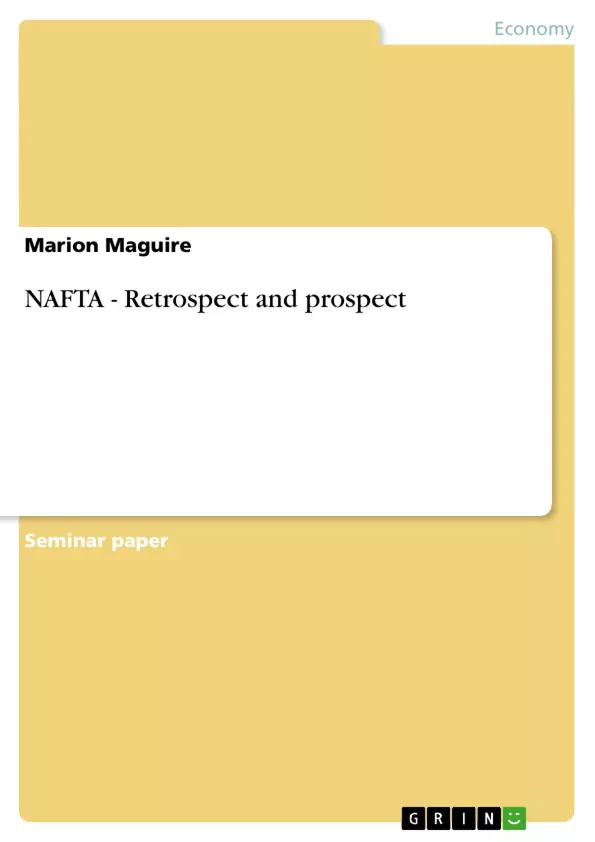To comprehend what is driving U.S. trade and investment policy requires an understanding of simultaneous developments occurring in investment, production, and trade. World exports grew more during the past decade than world production, indicating increased international interdependence. The growth in trade was made possible by improvements in transportation and communication networks, but also by the steady reduction of trade barriers.
On January 1, 1994, the North American Free Trade Agreement (NAFTA) came into effect among Canada, Mexico, and the United States. The agreement provides a detailed framework for the conduct of trade among the three countries. But its objectives are much more expansive than trade alone: The agreement is designed to remove barriers to investment among the three countries, permit the free flow of services, and enable expeditious settlement of trade disputes. NAFTA is an economic agreement that should influence where and how goods are produced and how services are provided in North America. NAFTA should have a positive effect on income and employment in each of the three member countries. These effects should be greatest in Mexico, the least developed of the three.
Inhaltsverzeichnis (Table of Contents)
- INTRODUCTION
- Purpose and Importance of the study
- Statement of the problem
- Limitations
- THEORETICAL OR PRACTICAL FOUNDATION
- Introduction
- Theoretical or practical basis
- RESOLUTION PROCESS
- Introduction
- Data
- Location of the data
- ANALYSIS
- Introduction
- Retrospect
- Prospect
- CONCLUSION AND RECOMMENDATION
Zielsetzung und Themenschwerpunkte (Objectives and Key Themes)
The study aims to analyze the effectiveness of the North American Free Trade Agreement (NAFTA) by examining its impact on trade and economic integration among Canada, Mexico, and the United States. The study explores both the positive and negative aspects of NAFTA, considering the potential benefits and challenges of free trade agreements.
- International trade and economic integration
- Impact of NAFTA on trade barriers and investment
- Benefits and challenges of free trade agreements
- Comparative analysis of NAFTA's effects on member countries
- Potential future implications of NAFTA
Zusammenfassung der Kapitel (Chapter Summaries)
- Introduction: This chapter sets the context for the study by outlining the purpose, importance, and limitations of the research. It highlights the growing global interdependence and the role of international trade in facilitating economic growth. The chapter also discusses the potential winners and losers of international trade, emphasizing the need for a nuanced understanding of the impact of trade agreements like NAFTA.
- Theoretical or Practical Foundation: This chapter explores the theoretical and practical foundations of international free trade, focusing on the "bottom up" and "top down" approaches to economic integration. It examines various forms of economic cooperation, including free trade areas, customs unions, common markets, and economic unions, illustrating these concepts with examples. The chapter also discusses the role of multilateral trade agreements like GATT/WTO in promoting global free trade.
- Resolution Process: This chapter delves into the implementation and administration of NAFTA, examining the processes and mechanisms established for resolving trade disputes among the member countries. It provides insights into the practical aspects of managing a free trade agreement and ensuring its smooth functioning.
- Data: This chapter outlines the data sources and methods used for analyzing the impact of NAFTA. It discusses the location and availability of relevant data, providing a clear understanding of the data collection and analysis process.
- Analysis: This chapter presents a comprehensive analysis of NAFTA's impact on trade, investment, and economic growth, examining both the short-term and long-term effects of the agreement. It explores the challenges and opportunities presented by NAFTA for each member country, considering factors such as industry competitiveness, job creation, and economic development. The chapter also discusses the future prospects of NAFTA and its potential role in shaping regional and global trade patterns.
Schlüsselwörter (Keywords)
The main keywords and focus topics of this study include international trade, economic integration, free trade agreements, NAFTA, trade barriers, investment, economic growth, competitiveness, job creation, and regional development. These terms reflect the core concepts and themes explored in the research, encompassing the impact of trade agreements on economic performance and the challenges and opportunities associated with global economic interdependence.
- Quote paper
- Marion Maguire (Author), 2003, NAFTA - Retrospect and prospect, Munich, GRIN Verlag, https://www.grin.com/document/20214



